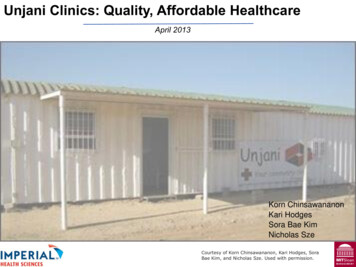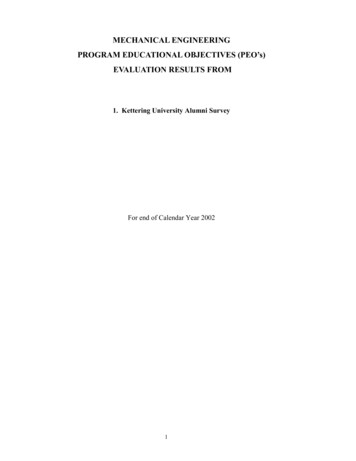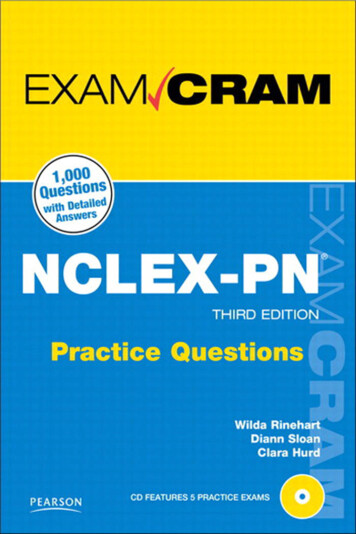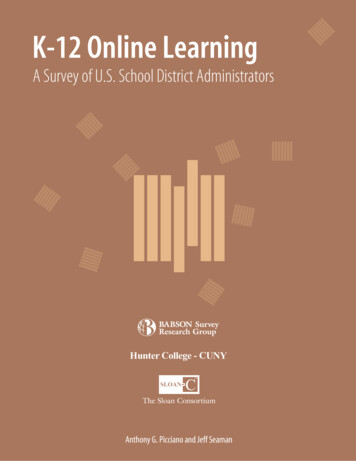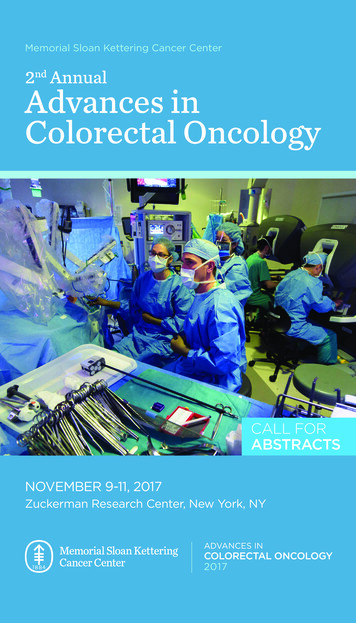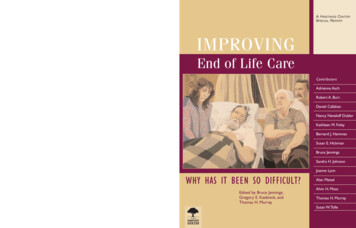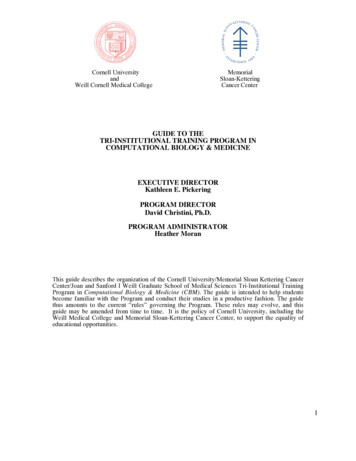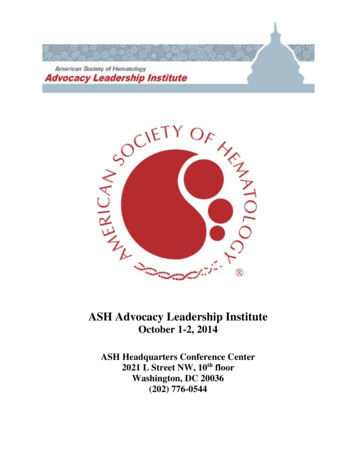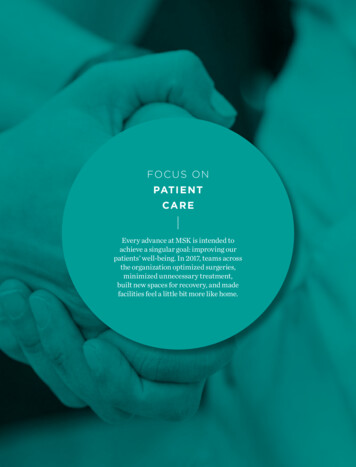
Transcription
FOC US O NPATI E NTCAR EEvery advance at MSK is intended toachieve a singular goal: improving ourpatients’ well-being. In 2017, teams acrossthe organization optimized surgeries,minimized unnecessary treatment,built new spaces for recovery, and madefacilities feel a little bit more like home.
Lyndell Kegerise (right)was among the first tostay in MSK’s 75th StreetPatient Residence, anapartment-style facilityfor people recovering frombone marrow transplants.
ONE FOCUSJUST LIKE HOME56MEMORIAL SLOAN KETTERING CANCER CENTER
ONE MSKA CONVERSATION WITHLYNDELL KEGERISEMSK patientWESLEY KEGERISELyndell’s husbandLife at the Jersey Shore wasgood for Lyndell Kegerise. Theformer real estate professionalwas diagnosed with non-Hodgkinlymphoma in 2005, but underthe care of MSK oncologist PaulHamlin, her disease went intoremission and stayed there foreight years. But in 2014, whenshe was 66, her disease relapsed,and then relapsed again in2015. When chemotherapy andimmunotherapy couldn’t keepher in remission for longer thana year, Mrs. Kegerise and herhusband, Wesley, learned thather best option was a stem celltransplant with hematologiconcologist Craig Sauter.LYNDELL KEGERISEIn January 2017, Dr. Hamlin said that we wererunning out of options. That hit me hard. He said thatI would be a great candidate for a stem cell transplantand he’d like me to meet Dr. Sauter, who wouldperform it.CRAIG SAUTERLyndell had high-risk disease, so that dictated thetransplant. When patients approach 70, we havea little more pause, but she didn’t have any majormedical problems.WESLEY KEGERISEOur MSK team found a donor through the Be theMatch program — this 25-year-old fellow who was awonderful match. We’re extremely grateful to him.LYNDELL KEGERISEI was afraid he was going to back out after I initiallydidn’t achieve remission. I hope I get to meet thisman one day because he stuck in there with me. Hewas ready when I was ready.A NEW PLACE TO HEALMr. and Mrs. Kegerise had looked into staying at aNew York City hotel while she recovered from hertransplant, until a nurse at MSK Basking Ridgegave them another idea: MSK’s brand-new 75thStreet Patient Residence, an apartment-style facility forbone marrow transplant patients and their caregiversthat opened in 2017. The studio, one-, and two-bedroomunits are outfitted with full kitchens, bathrooms,laundry, cable TV, and Wi-Fi. For some patients, theirstay may be covered by insurance.continuedLeft: Wesley and Lyndell Kegerise at the 75th Street PatientResidence. Above: Mr. Kegerise and Noel Neylon. Right:Mrs. Kegerise’s doctor Craig Sauter.2017 ANNUAL REPORT57
ONE FOCUSLYNDELL KEGERISEEric, one of my chemo nurses at MSK Basking Ridge,said, “You know, the new facility might be open bythe time of your transplant.” The next time I wasback, he said, “Lyndell, it opened!” So I pursued it.CRAIG SAUTERI thought it was great because she lives in New Jersey.She didn’t need inpatient care, but we like to have ourpatients close by for follow-ups. It’s a good resourcefor patients who need to be here frequently.WESLEY KEGERISEWe said, “This is great — take our reservation now!”When your loved one is going into a long hospitalstay, what is the caregiver going to do? How are yougoing to go back and forth? All of these thoughtswere going through my head. But MSK was sensitiveto the needs of the caregiver as well as the patient.At a hotel, the room isn’t sanitized. They don’tunderstand your medical needs. But here the staffis trained to understand the needs of the patient.The people at MSK work so wellintegrating with all the departments thatthe patient doesn't have to worry aboutanything except getting better.”–WESLEY KEGERISELYNDELL KEGERISEThey thought of things we didn’t even think about.Our air was filtered. Our water was filtered.WESLEY KEGERISEThis is the remarkable thing about MSK. The75th Street Patient Residence team was so easyand wonderful to work with. I had to move ourreservation about six times because we didn’t exactlyknow when Lyndell would be OK for the transplant,and nothing was a problem for them. Your room isready when you’re ready. The people at MSK workso well integrating with all the departments that thepatient doesn’t have to worry about anything exceptgetting better.LYNDELL KEGERISEEverything was coordinated for us. We just had toshow up. And it was wonderful being on the east sidenear the hospital, so we didn’t have to go across town.LIFE AFTER TRANSPLANTMrs. Kegerise had her transplant and stayed inMemorial Hospital to recover for 30 days. Mr. Kegerisestayed at the residence. Then Mrs. Kegerise joined himat the residence a few blocks away, where they stayedfor 40 more days.LYNDELL KEGERISEEven when you get out of the hospital, you’re stillgoing to see the transplant team every other day.The whole coordinating team at the 75th StreetPatient Residence made it easy for us. They wouldcall in the evening and say, “Your van will be hereat 8 am” to go to the hospital. If for some reasonit was late, they would call a driver.WESLEY KEGERISEAt the residence, you have your own little apartment.If Lyndell wanted to take a nap, she could go in thebedroom and I could be in the living room watchingTV. That’s a real benefit. And the staff couldn’t bemore accommodating. Lyndell loves Bigelow minttea, and they even got it for her. The session assistant,Ritsuko, and door attendant, Terry, would call usand say, “Do you need a ride in tomorrow at a certaintime?” Noel, the superintendent who changed thefilters, was so nice.LYNDELL KEGERISEHe became like our family.NOEL NEYLON (MAINTENANCE SUPERVISOR)“We try to provide a warm and casual environment,” says Noel Neylon, seenhere in one of the residence’s apartments. “Our patients have enough hardships to deal with. They shouldn't have to worry about having any problemsat their home away from home.”58I know the people who stay with us, like theKegerises, need support from our entire staff.Doing everything I can to create a warm, friendlyenvironment for patients and their families to comehome to is very important to me. I am proud to havebeen at MSK for more than 23 years, and I hope thatwe can continue to make a difference in our guests’experiences by treating them like family.MEMORIAL SLOAN KETTERING CANCER CENTER
ONE MSKThe couple on their wedding day in 1968 (left), and Lyndell Kegerise in treatment at MSK (right).A COMMON BONDLYNDELL KEGERISEAt the residence, you are with people who are goingthrough the same thing as you. We met a gentlemanwho worked on 9/11 and got blood cancer. Webefriended a family from Saudi Arabia, and the sontook Wesley under his wing. He cooked for him. Thenight before we left, they said, “Come down to ourapartment and spend some time with us.” At the endof the evening, the father, who was also a transplantpatient, gave me his prayer beads.WESLEY KEGERISEMost days I would go with her to her appointmentsand have lunch with her. Some days I would go tothe art museum or the Museum of Natural History.A couple days I would hit golf balls at Chelsea Piers.I could go back for lunch, see her in the afternoon,and walk home in the evening. It was so convenient.LYNDELL KEGERISEI encouraged him to get out. I said, “I’m taken care of— it’s you I’m worried about! Go do something fun.”LYNDELL KEGERISEThat was very nice. Our Saudi Arabian family wasable to join us for pizza in the common area.In October 2017, Mrs. Kegerise was clearedto return home.LYNDELL KEGERISEI was nervous leaving, but it was very coordinated.I had a little setback at Christmas — I got an infectionso I was back in the hospital — but I’m doing great.I feel great. I have energy, and I’m getting stronger.Every December, I would have scans done, and thecancer was always back. This was the first timein three years I didn’t hear the word “cancer” atChristmas. It was unbelievable.The couple will celebrate their 50th weddinganniversary in September.LYNDELL KEGERISEWe want all the special people in our lives over thepast 50 years to come celebrate with us. We are soblessed. Every day is a gift.WESLEY KEGERISEOur daughters came in from Delaware and Atlanta.They could stay with me at the residence whileLyndell was in the hospital. That was anotherbeautiful thing: People could visit.2017 ANNUAL REPORT59
ONE FOCUSSEEING PROSTATE CANCERIN A NEW LIGHT60MEMORIAL SLOAN KETTERING CANCER CENTER
ONE MSKThe whole ambience theycreated was just outstanding.I always felt that if I ever hada diagnosis of cancer, I wouldnot walk but run to MSK. Andthat’s exactly what I did.”–GREGORY PAGENew York City dentist Gregory Page came to MSK for a less-invasiveapproach to prostate cancer treatment. After undergoing light-activatedtherapy with Jonathan Coleman, Dr. Page was able to resume his normalactivities within days, including lunch at the Renaissance Harlem, nearhis office.DOCTOR BECOMES PATIENTAs a dentist, Gregory Page knew theimportance of staying on top of his health.He had prostate-specific antigen (PSA)tests, which measure for a protein inthe blood that is elevated in men withprostate cancer, as part of his regularroutine. When his PSA came backabnormally high in 2007, he made sureto see his doctor each year to moreclosely monitor his level.In April 2017, his doctor saw thatDr. Page’s PSA had risen high enoughto warrant a biopsy. The test cameback positive for cancer. The news wasunderstandably difficult for Dr. Page totake in — even more so because it cameon top of what had been a challengingyear so far. His godmother, best friend,and brother had all recently died.“It was not a good year for me,”recalls the 68-year-old from New YorkCity. “I said, ‘God, you’re giving me a lotto handle here.’ ”Dr. Page was already under the careof a urologist, but hearing he had cancermade him reconsider where he wantedto go for treatment. He remembered thetimes he had escorted one of his goodfriends, a lung cancer survivor, to MSK’sRockefeller Outpatient Pavilion.continued2017 ANNUAL REPORT61
ONE FOCUS“The whole ambience they createdwas just outstanding,” he says. “I alwaysfelt that if I ever had a diagnosis of cancer,I would not walk but run to MSK. Andthat’s exactly what I did.”Before calling MSK’s PatientAccess Service, which schedules firstappointments for people coming to MSK,Dr. Page researched urologists online.When he saw a YouTube video of MSKurologic surgeon Jonathan Coleman,he knew he had found the doctor hewanted to see.Dr. Page recalls, “Dr. Colemandiscussed the various treatments forprostate cancer, and he also used theword ‘cure,’ ” which is possible for manymen with prostate cancer. “That’s a goodword to hear when you have cancer,”he adds.Another point in the video thatreally resonated with Dr. Page was whenDr. Coleman said that the procedureshe does have minimal side effects.“I had friends who had their prostatestaken out, and it took them years torecover,” Dr. Page says. “One of myfriends had incontinence problems fora year. I have another friend who hadto have a pump put in. I didn’t want allof that.”FINDING A LESS-INVASIVEOPTIONIn June, Dr. Page and his fiancée,Cynthia, met Dr. Coleman and his nurse,Connie Estes. Dr. Coleman remembershow impressed he was with Dr. Page’sknowledge of his circumstance.“He had definitely done hishomework,” Dr. Coleman says. “Hewas extremely intelligent and wellinformed. He was thoughtful, inquisitive,and concerned about his cancer whilealso being concerned about treating ittoo aggressively.”Ms. Estes was equally taken by thecouple. “They are both the nicest people,and every interaction we had was adelight,” she says. “It was obvious thatthey had researched prostate cancerand treatment.”She told the duo that Dr. Coleman wasdoing promising research with vasculartargeted photodynamic therapy, a formof prostate cancer treatment that usesa light-activated drug to zap prostatetumors with minimal side effects.Dr. Coleman has been offeringvascular-targeted photodynamic therapysince 2010. The procedure requires onlylight sedation — the same type used fora colonoscopy. Once sedated, the patientreceives a medicine called padeliporfin(Tookad ) through an IV. Then the doctorplaces a thin laser fiber into the prostategland, which activates the drug so it can killthe cancer. Patients can go home the same day.“There’s a need for new technology tobetter destroy cancerous tissue withoutharming the surrounding tissue, andthat’s where this type of therapy comesinto play,” Dr. Coleman says.Right now, vascular-targetedphotodynamic therapy is performedonly through clinical trials, and it’s notan option for every man with prostatecancer. However, efforts are under wayto make it more widely available.At their next meeting, Dr. Colemantold Dr. Page that he was recruiting menfor a trial that would bring vasculartargeted photodynamic therapy closerto US Food and Drug Administrationapproval. He had 30 out of the 50 menhe would need. Dr. Page knew this washis opportunity.“I looked at my fiancée, I looked atDr. Coleman, and I said, ‘Could I benumber 31?’ ” he recalls. “He said yes,and I hugged him like he was my longlost brother. I knew I was gettingworld-class treatment.”Above: Jonathan Coleman is hoping the drug becomesa mainstream option for men with this type of cancer.Right: Narrow optical fibers activate Tookad to destroyprostate cancer.62MEMORIAL SLOAN KETTERING CANCER CENTER
ONE MSKI remember I was soexcited to make that call.As an office practice nurse,you really get to knowpatients and their families.When the biopsy cameback benign, it was greatnews. It makes my daywhen I am able to call apatient with news like this.”–CONNIE ESTESConnie Estes helped prepare Gregory Page for his treatment with Jonathan Coleman.THE BIG DAY — AND AQUICK RECOVERYDr. Page had his procedure in October2017 at Memorial Hospital. He wenthome the same day. He had to stay inshaded light conditions for the first twodays he was home because Tookad isactivated by light, but his fiancée helpedhim pass the time.“When the 48 hours were up, I got up,put on my clothes, and went to a baseballgame. And I felt fine,” he remembers.After the procedure, the only sideeffect Dr. Page experienced was someminor soreness. And unlike other major2017 ANNUAL REPORTforms of prostate cancer treatment,he hasn’t had any serious issues withincontinence or erectile dysfunction.At his three-month postsurgery checkupin January, Dr. Coleman didn’t find anycancer. Ms. Estes relayed the good newsto Dr. Page.“I remember I was so excited tomake that call,” she recalls. “As an officepractice nurse, you really get to knowpatients and their families. When thebiopsy came back benign, it was greatnews. It makes my day when I am able tocall a patient with news like this.”Now, nearly a year postsurgery,Dr. Page is doing great. He’s busy atwork and helping plan Cynthia and hiswedding. He says this year is shaping upto be much better than the last.“As a healthcare provider, it’simportant for me to spread the wordabout positive things that can enhanceand prolong people’s lives,” he says.“I feel very fortunate that I was at theright place, at the right time, with theright doctor and staff. How many peoplecan say they had a complete turnaroundin nine months?”63
ONE FOCUSLisa DeAngelis (right) is searching for ways to improve outcomes for people with brain tumors and neurologic complications of cancer. Viviane Tabar studies the useof stem cells to model cancer and to repair brain tissue after injury. Dr. Tabar also leads the Multidisciplinary Pituitary and Skull Base Tumor Center at MSK.THE UNIQUE CHALLENGESOF BRAIN CANCERSINTERVIEW WITHVIVIANE TABARChair of the Departmentof NeurosurgeryLISA DEANGELISChair of the Departmentof NeurologyThere are few diseases as feared —or as challenging to treat — as cancersof the brain. But there are very fewdoctors in the field of neuro-oncologywith the expertise, experience, andcompassion of Lisa DeAngelis andViviane Tabar. Both have spent nearlyall of their distinguished careers atMSK. Dr. DeAngelis has been Chair ofthe Department of Neurology since1997; Dr. Tabar was named Chair of theDepartment of Neurosurgery in 2017.In addition to treating patients, bothdoctors also conduct groundbreakingresearch. They sat down to talk abouttheir approach to treating people withneurologic cancers, what makes MSKspecial, and much more.64LISA DEANGELISPeople have very different ideas about what makeslife meaningful. It’s important that we know whatthat means to all of our patients, so we can not onlytreat their disease but also help guide them throughdifficult decisions and honor their wishes and theirvalues, especially if they reach a point at which theymay not be able to articulate that. So you need toknow that early on.VIVIANE TABARI agree. I think it’s absolutely crucial to understandwhat patients really want and to tailor our treatmentto their expectations. I remember early in my careersomeone who had a large, benign tumor, and we werevery proud to have removed it completely. But thepatient was not really satisfied because she turnedout to be a wine connoisseur and she lost her abilityto smell. That impacted her quality of life far morethan we had anticipated.Obviously, some people deal with much morechallenging neurological and psychological problemsrelated to a brain tumor diagnosis than that. Thatkind of experience is why I often tell my traineesthat your first ten years as a surgeon are focused ondeveloping your skills and becoming a good surgeon.But what’s more challenging afterward is developinggood judgment.MEMORIAL SLOAN KETTERING CANCER CENTER
ONE MSKLISA DEANGELISIt’s also really important to understand that treatingthe family is an integral part of treating the patient.It’s the family who bears the consequences if theperson’s personality and identity are changeddramatically by their illness. In some ways, thefamily struggles more than the patient. I’ve oftensaid to people, “This is going to be harder on youthan it’s going to be on your spouse,” or father, orwhoever the patient is. I think that’s somethingthat we in the neurology world confront muchmore frequently than other doctors.VIVIANE TABARYes, that’s very insightful. The families do take ona large burden that sometimes leaves me in awe oftheir generosity. Brain cancers are probably someof the most challenging diseases to deal with.LISA DEANGELISYou sometimes ask yourself, “How do these peopleeven get out of bed in the morning and face the day?”I think it’s absolutely critical to understandwhat patients really want and to tailor ourtreatment to their expectations.”NEW DEVELOPMENTS INTHE FIELDLISA DEANGELISHaving taken care of people with glioblastomaand malignant brain tumors for more than 30 years,I really have seen a noticeable improvement in thequality of life for people who live with these diseases.One reason is newer drugs, such as temozolomide[Temodar ], which is much less toxic than priorchemotherapies and better tolerated. Also, theaddition of bevacizumab [Avastin ] has helpedpatients avoid corticosteroids for brain edema orswelling and the attendant side effects. That’s beenvery gratifying and enabled patients and families tomake the best use of whatever time they have left.The other thing that’s changed is that there arepeople who are living many years with this illness.That’s not something that we saw — or saw very rarely— in the ’80s and ’90s. It’s important to understandthat the proportion of these people is very small. Andthe fact that we haven’t substantially prolonged lifefor more patients is the most important problem thatwe struggle with. But those people who live for six orseven years after treatment often do extraordinarilywell. They are able to work and enjoy life. That’s adramatic change.continued–VIVIANE TABARIt’s also really important to understandthat treating the family is an integral partof treating the patient. It’s the family whobears the consequences if the person’spersonality and identity are changeddramatically by their illness.”–LISA DEANGELIS2017 ANNUAL REPORT65
ONE FOCUSVIVIANE TABARIn the neurosurgery department, we’ve evolved overthe last ten years to put a greater focus on offeringsurgery while maximizing function. That’s in partbecause of technologies that I expect will continueto evolve and allow us to offer people more options.Take, for example, patients who suffer from brainmetastases, when cancer spreads from another partof the body. Traditionally they were told that their lifeexpectancy was a year or less, and I would admit thatthey perhaps received less attention from surgeonsin the past. But today, we often focus our discussionon what surgery can do to improve quality of life. Ifa patient suffers from a weak leg or a weak arm, weare more likely to offer them surgery if we think thatit can help them overcome that deficit, even if wecannot impact life expectancy.THE IMPORTANCE OF TREATMENTLISA DEANGELISWe’ve seen in both of our disciplines, whether withprimary or metastatic tumors, that there can berecovery of function. Particularly with primarytumors, I think there was a lot of therapeutic nihilismassociated not only with the fact that these aredifficult cancers to treat but also with the long-heldbelief that people could not recover neurologically.If they were left severely compromised from afunctional point of view, what was the point?But in fact we have learned that with multiple meansof treatment — surgery, radiation, chemotherapy —patients with very considerable deficits can makesubstantial recoveries and have a very meaningfulreturn of function. That’s been a paradigm shiftand is very encouraging therapeutically.VIVIANE TABARIn the neurosurgery department, we’veevolved over the last ten years to put agreater focus on offering surgery whilemaximizing function.”Improving function also allows some people tobe eligible for more-aggressive treatments, forclinical trials or new drugs. I think that’s wherestrides are going to be made. Gains at the individuallevel and for a subset of patients are going to movethe field forward.–VIVIANE TABAR66MEMORIAL SLOAN KETTERING CANCER CENTER
ONE MSKWHAT SETS MSK APARTLISA DEANGELISMSK is about the people. It’s about the team. We havea fantastic multidisciplinary, collaborative team —people with deep expertise in their respective fields,such as neurosurgery, radiation oncology, neuralpathology and neural imaging, and so on.We work incredibly well together, which doesn’tmean that we always agree with each other. Infact, some of the most valuable exchanges arewhen we don’t agree. Somebody will bring anotherconsideration to the table that makes you thinkabout a problem or see a patient from a differentperspective, and you realize that perhaps youhaven’t considered every aspect of things.I’m absolutely convinced that this is all to thebenefit of the patient. There is no question in mymind that what we bring to the table collectivelyfar exceeds the sum of the individual parts.VIVIANE TABARI agree. The depth of expertise and dedication ofmy colleagues at MSK is really what keeps me andmy patients afloat. There’s great comfort in beingable to discuss a challenging case with the group.To listen to the input of people with deep experienceas well as younger people who have a differentperspective — people who have one foot in the laband one foot in the clinic, or those who are willingto challenge the norm.It’s also very inspiring to be surrounded by notonly clinical and scientific excellence but also peoplewith genuine dedication to the patient. It’s no secretto all of us that this is a challenging job, particularlycaring for people with brain tumors. We lose a lotof patients. It would be terrifying if you didn’t haveyour colleagues next door.When we are facing a difficult surgery or a difficultoutcome from surgery, it’s very reassuring to usand to the patient to be able to reach out to ourneuro-oncologists, who sort of pick up the personwhere he or she landed and move them to the nextphase. That provides not only support to each otherbut also support to the patient, giving a differentperspective and usually a positive outlook onwhat’s to come.VIVIANE TABARYes. It’s the norm for me if I get a thank-you notefrom a patient that also refers to my nurse.LISA DEANGELISAbsolutely.VIVIANE TABARThey are an invaluable component of what we do.And I think the patients definitely appreciate it.Our nurses contribute to patients’ well-beingthroughout their hospital stay and afterward.The patients definitely appreciate the team effortamong doctors too. It’s not uncommon for us tosay to patients, “Well, let me discuss this with mycolleagues and we’ll get back to you.” I enjoy whenthe patient is a little incredulous that you get backto them the following day with an opinion fromseveral experts that would have taken maybe afew months to get individual appointments with.That model works extremely well between ourtwo departments.LISA DEANGELISOur global team approach is so different from otherinstitutions that it does sometimes take patientsand families a little bit of time to acclimate to it.But I think they rapidly come to appreciate thebenefit of it.There is no question in my mindthat what we bring to the tablecollectively far exceeds the sumof the individual parts.”–LISA DEANGELISLISA DEANGELISOur nurses and nurse practitioners are a criticalcomponent of this. They’re very much a part of ourteam. We are so fortunate to have an incrediblenursing workforce here, including the floor nursesand the advanced practice nurses. Nurses are ourfront line to patients — we jointly share that focuson addressing patient and family needs.2017 ANNUAL REPORT67
ONE FOCUSINTERVIEW WITHLEE ERICKSONDeputy Physician-in-Chieffor Clinical OperationsCHRISTIAN OTTODirector of TeleoncologyA BOLD NEW TAKE ON CARELEE ERICKSONImplementing telemedicine is about a biggerparadigm shift. We want to move the majority ofcancer care out of the healthcare setting entirely.Instead of making you come to us, we’ll come toyou. If we can turn this whole model inside out,it’d be amazing.CHRISTIAN OTTOTelemedicine uses electroniccommunications such asvideo conferencing andsecure email to provide carewithout an in-person visit.Here, Lee Erickson, DeputyPhysician-in-Chief for ClinicalOperations, speaks withChristian Otto, Director ofTeleoncology, about thisburgeoning field at MSK. Theyboth joined MSK in early 2017.Telemedicine can have a significant impact onquality of life. When patients feel unwell and we’reasking them to travel, that can be challenging.We’re also seeing data showing survival benefits. Forexample, take a study done by [MSK epidemiologist]Ethan Basch that was presented at the AmericanSociety of Clinical Oncology annual meeting inJune 2017.LEE ERICKSONIt showed five months of additional survival justfrom having patients report their symptoms totheir physician.Lee Erickson (right) and Christian Otto are bringing new and existing technologies to MSK to allow patients to receive care virtually.68MEMORIAL SLOAN KETTERING CANCER CENTER
ONE MSKCHRISTIAN OTTOAnd that’s only one component of symptommonitoring at home. We haven’t even added coaching,in which nurses educate patients on correctivebehaviors, or the collection of biomedical data.What if we were able to identify an infection earlyby following our patients’ temperatures, and thenstart antibiotics several days earlier?LEE ERICKSONI’ve read about gadgets being worked on that dosimple lab tests through your smartphone. Prick yourfinger and instead of putting the blood into a glucosemachine, it’s a little insert that goes into your phone.CHRISTIAN OTTOMAKING APPOINTMENTS EASIERCHRISTIAN OTTOI think we will get to a place where the majority ofpreoperative assessments, symptom management,oncology follow-ups, postoperative woundchecks, and discussion of results could be done viatelemedicine. And on the other side, there areUber-like services that go to the patient’s home.LEE ERICKSONWe had a patient who had his blood drawn at hiskid’s Little League game.CHRISTIAN OTTOThese tools give a full picture of how the patientis doing. It’s being present almost 24-7 versus anoncologist receiving a call when the patient is havinga challenge.We’re not trying to do away with face-to-faceinteraction. We really want to supplement thetimes that we’re not with a patient, and perhapsmake some of their appointments easier by havingthem stay home.TELEMEDICINE IN ACTIONLOOKING AHEADLEE ERICKSONPatients at the Josie Robertson Surgery Center usea program within our patient portal to report howthey’re doing once they’re home, and they seem veryhappy with it. Say we send you a message every dayasking how your pain is, and on day three you textus and say, “Shouldn’t I be feeling better by now?”We’ve actually accumulated enough data to show youa chart for pain that’s normal, and you can compareyourself against it. Patients like it. They feel safer andmore connected.CHRISTIAN OTTOI think there’s a level of comfort in it. At MSK, wehave implemented a falls prevention program thatpatients are asked if they’d like to participate in.It involves having a camera in the room that lets thenursing staff monitor the patient. You can place avirtual border around the patients who are at highrisk for falls so that an alarm sounds if they try toget up unassisted.LEE ERICKSONThen the person watching the monitor cansay to the patient through the system, “I’ll comehelp you.”CHRISTIAN OTTOFirst, we’re expanding telemedicine across ourManhattan sites. Then we’re moving into theregional sites. We have a number of pilots in serviceslike genetics and psychiatry. Our third prong isgoing to the patient’s home.LEE ERICKSONI think of it like smartphones. In the beginning,they were this really expensive thing for people withdisposable income. But we hit a tipping point, and itchanged the culture. A similar thing needs to happenin healthcare. When we hit another tipping point,I think we’re in for some maj
husband, Wesley, learned that her best option was a stem cell transplant with hematologic oncologist Craig Sauter. Left: Wesley and Lyndell Kegerise at the 75th Street Patient Residence. Above: Mr. Kegerise and Noel Neylon. Right: Mrs. Kegerise's doctor Craig Sauter. A CONVERSATION WITH. LYNDELL . KEGERISE. MSK patient. WESLEY . KEGERISE .
